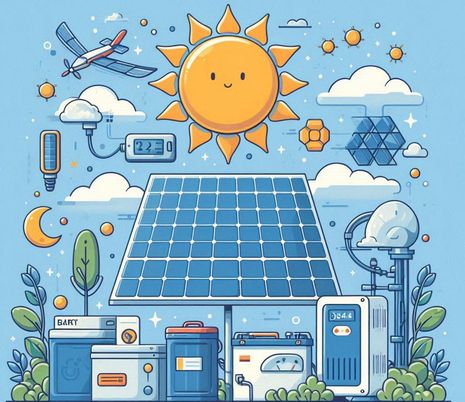

How to Design an Off-Grid Solar System?
Off-grid solar systems are independent power sources not connected to the grid. These systems are especially crucial in areas where the grid is inaccessible or where the electrical infrastructure is weak. Off-grid systems generate and store electricity using solar energy, providing power when needed. So, how do you design an off-grid solar system? Here is our step-by-step guide.
Factors to Consider When Designing an Off-Grid Solar System
There are several critical factors to consider when designing an off-grid solar system. These factors play a key role in ensuring the system operates efficiently:
- Energy Needs Calculation: The first step in system design is determining the energy consumption of the devices used. This calculation helps accurately determine the solar panel capacity.
- Solar Panel Selection: Solar panels are the most important component in electricity generation for off-grid systems. The panel capacity should be determined based on the energy required.
- Storage System (Battery): To use solar energy at night or on cloudy days, an energy storage system is needed. Calculating the correct battery capacity is essential for this purpose.
- Inverter Selection: An inverter is required to convert the direct current (DC) from the solar panels into alternating current (AC). The inverter should be selected according to the voltage and frequency needs of the devices to be used.
- System Redundancy and Security: To ensure long-term uninterrupted operation, consider redundant batteries, regular maintenance, and monitoring systems.
Step-by-Step Off-Grid Solar System Design
You can follow these steps to design an off-grid solar system:
- Step 1: Calculate Energy Needs: First, calculate the total power consumption of the electrical devices to be used in your home or facility. This is a critical step in determining the system's energy capacity. Consider the power consumption of all devices in watts (W) and their operating times.
- Step 2: Calculate Solar Panel Capacity: When determining the capacity of the solar panels, consider your daily energy needs and the sunlight hours in your region. Solar panel capacity can be calculated by dividing the total daily energy requirement by the hours of sunlight.
- Step 3: Calculate Battery Capacity: While solar panels generate energy during the day, stored energy can be used at night or on cloudy days. Therefore, choose a battery capacity large enough to meet your daily energy needs. Battery capacity should ensure the system can operate throughout the night.
- Step 4: Choose the Inverter: The inverter's capacity must be appropriate for converting the direct current (DC) generated by the solar panels into the alternating current (AC) used in your home. The inverter's power should match the total power of the devices to be used.
- Step 5: Install and Test the System: After correctly placing and connecting all components, test the system. Once you ensure the system is working properly, the installation is complete.
Advantages of Off-Grid Solar Systems
Off-grid solar systems offer a range of advantages:
- Independence: You can generate your own energy without relying on the grid. This is an ideal solution, especially for those living in remote areas.
- Eco-Friendly: Solar energy is a renewable and clean energy source. Off-grid systems do not harm the environment and reduce carbon dioxide emissions.
- Long-Term Savings: Although the initial cost is high, savings can be achieved over time on grid electricity bills.
- Low Maintenance Cost: Solar panels and batteries require minimal maintenance and are relatively simple to maintain.
Disadvantages of Off-Grid Solar Systems
Off-grid solar systems also have some disadvantages:
- High Initial Cost: The installation cost of the system can be high initially. However, long-term savings will compensate for this cost.
- Limited Energy Storage: Batteries have limited energy storage capacity, so additional batteries may be needed in cases of prolonged energy demand.
- Maintenance Requirement: Batteries may require replacement after a certain period, adding extra costs.
Conclusion
Off-grid solar systems are an excellent alternative for those looking for energy solutions not connected to the grid. With proper design, accurate energy calculation, and appropriate solar panel and battery selection, a sustainable and efficient energy source can be provided. These systems offer an eco-friendly and economical solution but require consideration of initial costs and maintenance needs.
If you live in a remote area and want to meet your energy needs without relying on the grid, off-grid solar systems might be an ideal option for you.
